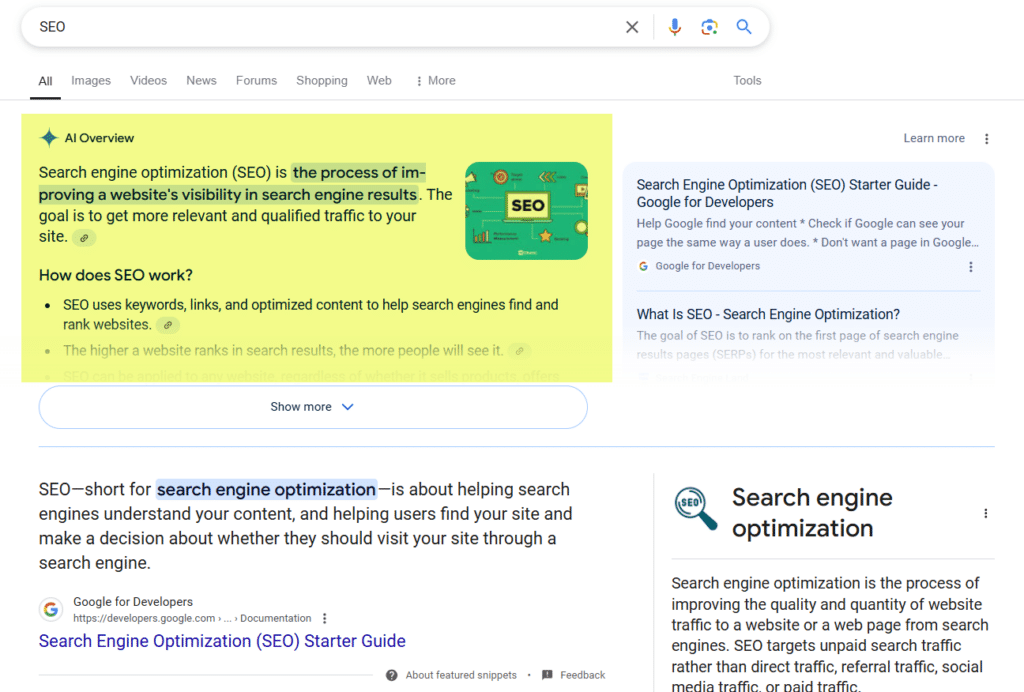Is Your Business Ready? How Google Search Changes Will Impact Your Visibility in 2025
Google search changes are always a topic of discussion because Google is by far the number one tool customers use to help them make smart, informed buying decisions. In fact, three out of five consumers use Google to research before making a purchase. While social media can certainly influence spending habits, studies consistently show that even insomnia-fueled, emotional spending, and celebration purchases are usually researched on Google prior to users clicking the buy button.
So, whether learning about new search features, options, or parameters inspires excitement or overwhelms you, as a small business owner, ignoring the value of optimizing your products and services to appear in Google results simply isn’t a viable choice. There’s just no denying the importance of understanding how Google affects the delivery of search results! Because how those changes apply to consumers’ interactions with your business is the number one driver behind capturing more leads and converting more customers.
Learning about the latest innovations in Google Search and keeping up with search technology updates is a necessary evil of business ownership. To help you stay current, we’re sharing the five biggest search innovations you need to be aware of in 2025.
1. AI Overviews offer answers

Noticed anything different in your own Google search results recently? In May 2024, Google rolled out their AI Overview feature to the entire U.S. market. Since then, this feature has been released in several other countries and is now available to more than 1 billion users.
The AI Overview is a text box that now appears at the top of most, if not all, search queries. This admittedly handy feature summarizes information from the top search results to create a cohesive, thorough paragraph, often with bullet points, presenting an answer to your question before you even click one link.
This innovation provides facts, figures, and statistics without you having to navigate away from the results page. Essentially, Google’s AI tool is conducting its own research and presenting the information to you. Not surprisingly, Google has found that users like this type of experience and actually use the search engine more frequently when AI Overview is available. The overview is spurring more visits to diverse websites, and research shows that users are clicking on links cited by AI Overview more than other search results.
Since these results are what first appears on the search engine results page, you may be concerned about optimizing your content to appear in this AI Overview. Fortunately, the guidance around how to take advantage of this feature is pretty standard. Focus on creating the most high-quality, keyword-rich, relevant content possible. Also, don’t forget to add helpful details to your website like headings, simple bullet points, and structured data. The goal is for Google’s AI to understand your pages, so citing authoritative sources and regularly updating your information helps, too.
2. Circle to Search
If you aren’t familiar with this term, there’s a good chance it’s because you’re an iPhone user. But, regardless of your cell phone preference, with 3.9 billion Android users worldwide, Circle to Search is a search feature you should be aware of. To note, because this is an incredibly popular tool among Generation Z, it’s only a matter of time before iPhone users are able to access this tool as well.
For those who aren’t familiar, Circle to Search is an innovative search feature available on most Android phones that has been available since January 2024. Users can circle anything they see on their screen—whether in their social feed, a random article, or even a paused YouTube video—and quickly conduct an image search. This means you can start a search query without ever leaving the page you’re looking at, avoiding much of the manic bouncing around that can happen while using smartphones.
Circle to Search is a convenient way for users to quickly look up anything that piques their interest before they forget or move on to another piece of content. From an e-commerce perspective, this ability supports most consumers’ non-linear customer journey. And, since a third of all users who have tried Circle to Search use it weekly, it’s unlikely to go away.
For small businesses, it’s important to know that this innovation thrives on images, so ensuring you have high-quality, original photos and videos on your website is a must. But appearing in a Circle to Search result takes much more than that. You also need to tag your visual media to ensure rich metadata. Adding captions and keyword-laden descriptions helps, too.
3. Looking through the Google Lens

Google Lens is similar to Circle to Search but focuses on analyzing images rather than text. This technology isn’t limited to Android, either—it’s available via the Google Lens app on all smartphones. Initially created just for the Google Pixel phone in 2017, this app is now used for more than 20 billion monthly searches. That makes Google Lens the fastest-growing query type. What’s even more significant for small business owners is that 25% of Google Lens queries have commercial intent.
Consider this likely scenario: You’re in a department store and see a jacket you like. You know this brand is carried at several different stores in your area, so rather than figuring out the style name, you simply open Google Lens on your phone, point your camera at the jacket, and allow it to do the research for you.
Your search results will show you Google Shopping listings for the same coat at many other stores—and a few are selling it for a better price! What’s your next move? Purchase the same jacket for a better price at a different store, of course!
This is the power of Google Lens, which as of September 2024 is even more dynamic. Users have always been able to search images with Google Lens, but now they can search videos, too. With this new technology, you can record a video and even ask questions about the video while recording! What’s even more incredible, Google will actually respond in real time!
When optimizing your content for Google Lens searches, always consider how Google perceives your data. To get users (and Google) where they need to go, you need a well-crafted schema, highly developed relevant, timely content, and a well-organized website with straightforward navigation, headings, and subheadings.
4. A more organized search
Google processes about 8.5 billion individual searches each day. Considering that every search yields several thousand to several million results, the amount of information flowing through Google is impossible to fathom.
Given the sheer volume of searches that are conducted, it’s not surprising that Google Search engineers are always looking for ways to present more organized results. The latest tactic is (surprise!) using AI to arrange the search results page and categorize related results into groups. This innovation focuses on intent and helps users find what they’re looking for faster than ever.
The roll-out for AI-powered search organization started with dining and recipes, and was quickly followed by movies, music, books, hotels, shopping, and more. So, the degree to which this change impacts you also depends on your business.
Regardless, you can prepare for future categorization by adding more unique content to your website that specifically pertains to niche segments within your business. Don’t forget to populate that content with metadata and use plenty of keywords to earn a higher rank—every category presents a new opportunity to be ranked at the top!
5. Find more with multi-step reasoning
Would you believe that 15% of all searches have never been searched before? Until the recent changes ushered in by AI and generative search, most queries were really pretty one-dimensional: What is the weather today? Vegan lunch ideas kids will actually eat. What really happened on the Titanic? Top causes of hair loss. Who won the latest season of The Masked Singer?
These examples of common searches are focused on single topics that are relatively easy to find information about online. The problem is that because they’re so broad, the search results are broad, too. Take the vegan lunch ideas query, for example. Sure, that’s what you’re looking for, but you also need the results to be peanut-free and made of ingredients in stock at a grocery store within 5 miles of your home. That’s where multi-step reasoning comes in.
As of last year, Google Search can accommodate more sophisticated, nuanced queries and you can expect high-quality results in return. Multi-step reasoning allows Google to break down a complex question into multiple searches and aggregate those results to provide a comprehensive answer.
Consider the questions your customers might ask that will lead to your business. Will they have multiple layers, and if so, what would they cover? Use this information to create content that appeals to your audience and is friendly to multi-step reasoning.
Search is here to stay, but how it works will always evolve. Understanding the latest Google Search innovations is required for modern marketing in the digital age. Talk with one of our marketing experts today to learn more!






